How to attract prospective residents with today’s top multifamily marketing strategies
Learn how to attract prospective residents with a powerful digital marketing strategy that includes an optimized website, informative listings, strategic paid advertising, and engaging organic content.
How do you attract more prospective residents to your multifamily community?
The property marketing landscape has shifted. Digital communication channels are more important than ever, and renters’ expectations have skyrocketed along with rent prices. How can multifamily communities successfully attract quality prospective residents in this new environment? A variety of inbound digital marketing activities are necessary in an effective lead capture strategy.
Let’s dive into some best practices for a powerful digital multifamily marketing strategy, including website development, listings, content marketing, social media, search engine optimization (SEO), and paid advertising.
How to attract prospective residents
- Boost your website’s digital curb appeal to prospective renters
- Level-up your listings
- Perfect your paid advertising plan to reach prospective renters
- Invest in SEO & organic content
Boost your website’s digital curb appeal to prospective renters
According to NMHC, 83% of prospective residents visited either the property, or property management company’s website at one point during their most recent rental home search. In an article for NAA, Ashley Tyndall, Chief Relationship Officer for Criterion.B, states that “today’s renters aren’t patient; they want to be able to find what they’re looking for on a webpage in under a minute or they’re going onto the next.”
Sometimes less is more. Uncluttered websites with ample whitespace, larger fonts, and longer homepages are on-trend. In addition to eye-catching imagery and a modern aesthetic, your homepage should also be easy to navigate. Be transparent with unit pricing and availability, and offer site visitors multiple options for tours, inquiries, or online applications.
“If someone were to come to your website or happen upon your community, what does your digital handshake look like? How would that experience be? Anywhere you can be found through a mobile device, desktop, through media, is telling your story” – Joe Melton, VP of Marketing & Management Support Services, The Morgan Group
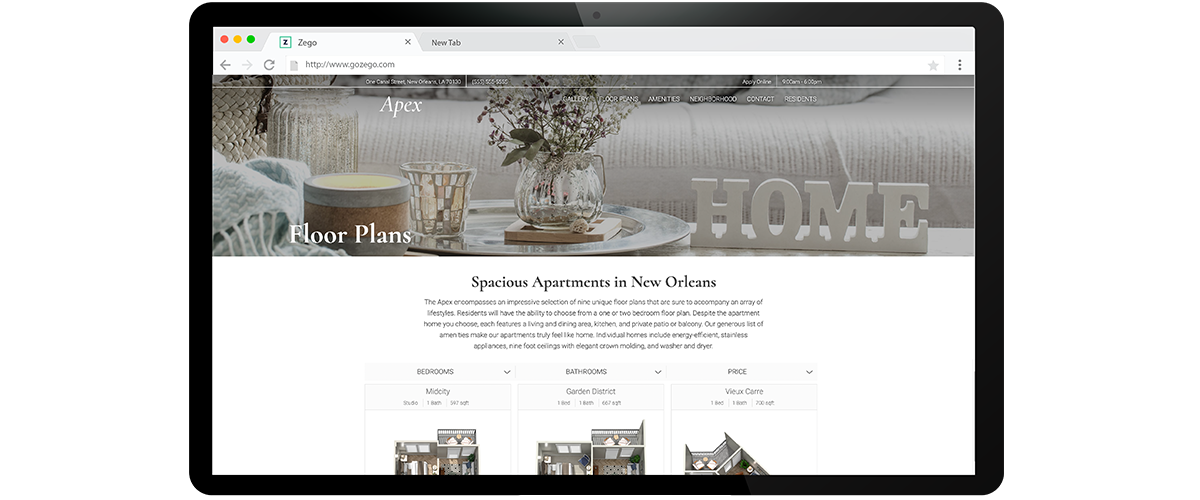
Non-negotiable checklist for your property website:
- User-friendly
- ADA compliant
- Mobile responsive
- Featured floor plans
- A list of amenities
- An image gallery
- Resident reviews
- An easily accessible ‘contact us’ form
- Info about the surrounding area & local schools
Increase site traffic
Companies with 10-15 landing pages increase leads by 55%. Build out landing pages that target keywords for your community such as, “apartments in San Diego.” Then, use Google Analytics to identify high-performing pages, as well as pages that need improvement.
The National Association of Realtors found that embedded video drives 157% more organic search results to your website. If you haven’t already, it’s time to start creating and showcasing your community via video.
Provide a seamless conversion experience
As technology and demographics evolve, a seamless conversion experience will not only meet prospective residents’ expectations, but provide a great first impression of your community. Apartment hunters want to land on your mobile-responsive homepage, easily find their preferred floorplan, fill out an e-application, and pay their application fee digitally within a few clicks.
Level-up your listings
Enticing listings are crucial to filling units quickly. We’ve put together this checklist to help enhance your listing game:
- A spicy headline: Start with an adjective followed by a description that includes the number of bedrooms and bathrooms, the location, and a highly sought after feature. For example, “Gorgeous 2 Bed/1 Bath Apartment in the Heart of Austin! Central Heat and AC Included!”
- Eye-catching images: Hire a photographer, or purchase a professional camera to capture high-quality images. Turn on the lights and open the blinds to allow for extra light. Do not add heavy filters to the photos. Finally, use a shot of the building exterior or the kitchen as the featured image.
- Bullet points: As our attention spans decrease, so should your listing description. Start with a short sentence or two about the rental unit and the surrounding community. Then move on to a list of bullet points that capture the best features of the unit.
- Call to action: Once they’ve found you on the ILS, no need to keep them there. Drive property management leads to your website with a clear call-to-action, such as “Apply Now.” A listing only lets you operate within a certain set of parameters, whereas your website gives you the opportunity to tell your community’s entire story.
- Video walkthrough: Listings that include a video draw 403% more inquiries than those without. The best video walkthroughs use voiceover to highlight square footage, recent upgrades, unique features, and community amenities.
Perfect your paid advertising plan to reach prospective renters
With highly-targeted, cookie-based ads omnipresent in our Google searches and social platforms, it’s not surprising that today’s top property marketers are also spending money on digital advertising. Zego’s 2022 survey of over 600 multifamily companies found that an average of $217 is spent per unit on advertising, up from the $204 average in 2021. Data also showed that the larger the portfolio, the more spend per unit is invested in advertising.

Digital advertising channels for property marketing
Property management advertising on social media channels allow for hyper-specific targeting, like zip codes and professions. Search engine ads help keep your properties top of mind even when your prospects are not on social media. Knowing your audience, and advertising on a mix of platforms is the best way to engage prospective residents, wherever they are spending their time online.
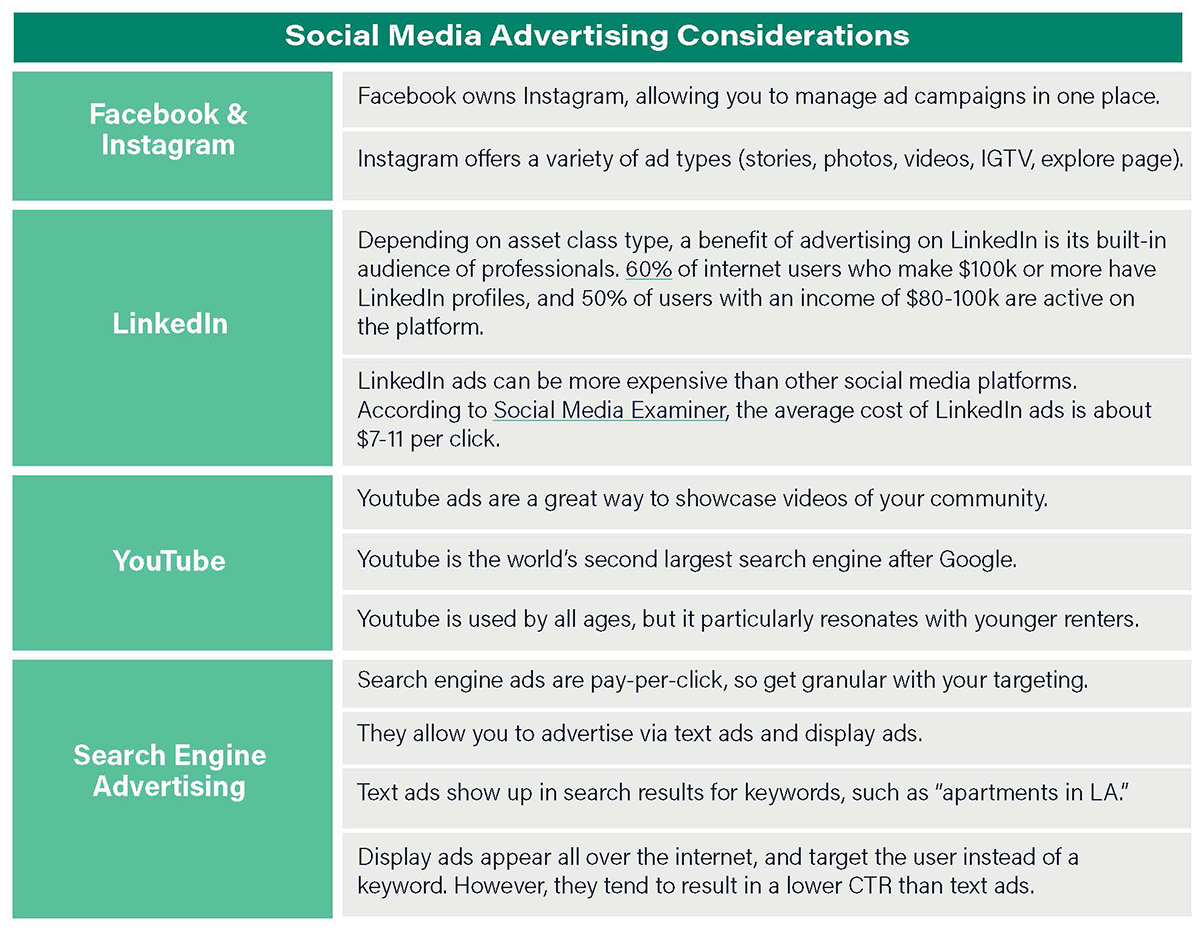
Best practices for paid property management advertising
- Pay attention to timing: A large portion of your advertising budget should be spent at the two month mark before peak moving season (in late-spring/early-summer).
- Offer an enticing discount: A promotional offer could be the deciding factor between your community and a competitor. Try waiving an application fee or offer a discounted deposit for those who apply by a certain date.
- Know your audience: Try offering discounts to specific groups of people such as students or veterans. This will really resonate if your community is located in a college town or near a military base.
- Test everything: Use different featured images to see what gets the most clicks. Refine and test different sets of audiences. Why stick to one CTA when you can test “apply now” against “learn more” against “view floorplans,” and so on.
- Track and measure your results: Ensure that you are able to accurately attribute each lead source. That way, you can analyze and track your ROI, and allocate precious ad dollars to the best performing channels for your renter demographic.
On Episode 208 of The Resident Experience Podcast, explore how property marketers can start to leverage tools available to them in order to gather and make better decisions using data. Featuring guest Erina Malarkey, co-founder of Remarkably.
Podcast: Use Data to Drive Higher Marketing Performance
Invest in SEO & organic content
If your property website is your digital front door, SEO is your Google Maps. Lead prospective residents to your page with an organic search strategy that will rank your website higher in the search engine results pages (SERPs). Optimize your website copy to target keyphrases that your prospects might be searching for. Adjust the meta description to a short and enticing sentence about your brand. Use outbound links, internal links, and plenty of images.
“Now is the perfect time to build an organic digital footprint to position your apartment community for the future.” Kerry W. Kirby, CEO at 365 Connect.
PropTech stack strategy:
Hire a web developer with SEO expertise. If your website is outdated and clunky, prospective residents will assume your property is too. Beautiful and intuitive web design enhances the prospect experience.
But don’t stop there! They say the best place to hide a dead body is on page 2 of Google’s search results. To get your property seen, a good website development provider can help your page to rank as high as possible.
Google My Business
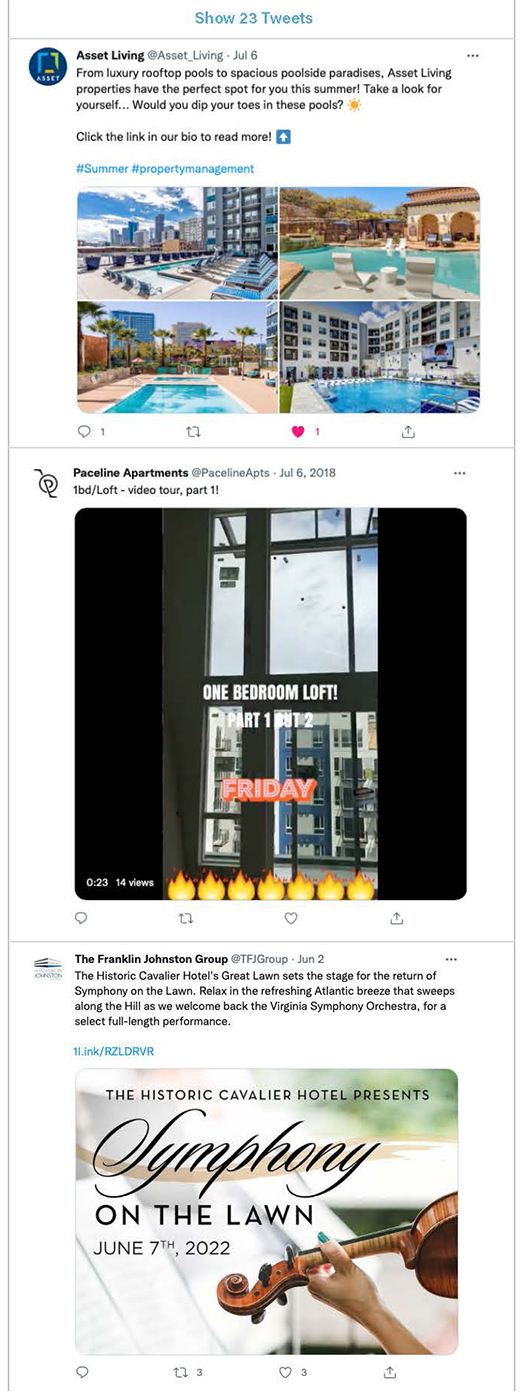 A well-maintained Google My Business account is key to localized exposure. 365 Connect offers some best practices on how to create, verify, and optimize your Google listing. Editing and updating your property information on Google, as well as managing resident reviews is vital to your digital marketing strategy. Parcel Pending says, “A multifamily community’s Google Business listing is just as important as its website. Google My Business receives tons of traffic from potential residents.”
A well-maintained Google My Business account is key to localized exposure. 365 Connect offers some best practices on how to create, verify, and optimize your Google listing. Editing and updating your property information on Google, as well as managing resident reviews is vital to your digital marketing strategy. Parcel Pending says, “A multifamily community’s Google Business listing is just as important as its website. Google My Business receives tons of traffic from potential residents.”
Organic social media
Google found that almost 40% of consumers between the ages of 18-24 are searching for restaurants and hot spots on Instagram and TikTok instead of Google Search or Maps. So if you are looking to attract younger renters, showcase your community on TikTok.
“I don’t think that we see a direct correlation to rent revenue by having an Instagram profile or a Facebook profile. But I think you tie that back to the resident experience. You tie it back to being where the prospect wants to find you. You tie it back to having an additional piece of authority online. It is a trigger for SEO. The more authority that you can build, the more respect you’re going to get from Google.” – Zoe Adams, Senior Manager, Marketing at NRP Group
While TikTok does not yet have a map-based search function, using the correct keywords in your captions will help you land on younger renters’ For You page (#FYP).
Instagram does have place-based search functionality, allowing users to see and promote user-generated content (UGC) filmed in that location. Mike Whaling, Founder and President of 30 Lines, urges property marketers to “encourage residents to tag their photos at your property when they’re at the pool, at the dog park, or at a resident event. Those photos show up when others do a search for your location.”
Location-based Instagram UGC
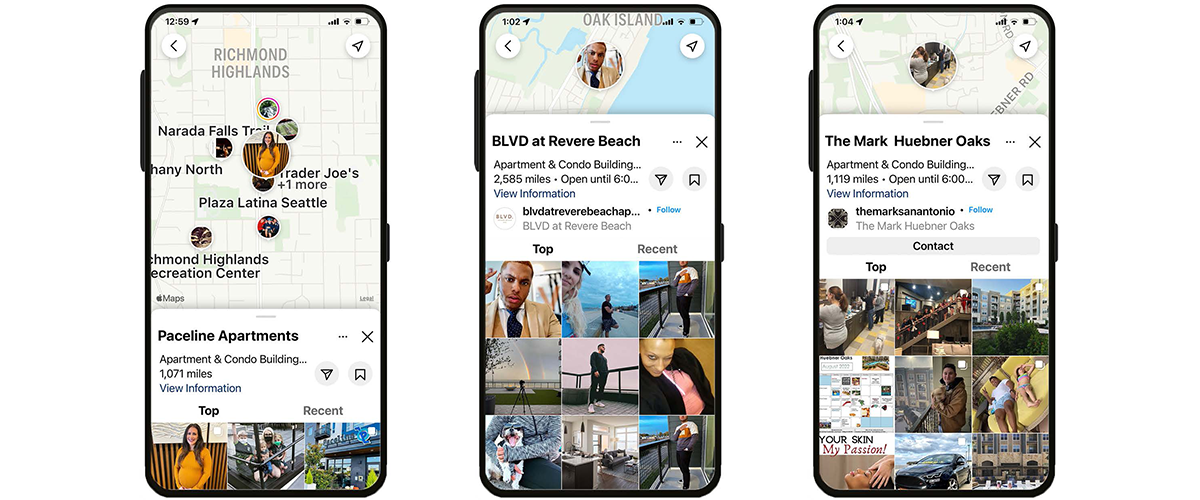
As consumer behaviors shift, prospective residents will expect to find information about your community on the platforms where they spend their time. NMHC reports that 45% of renters visited the social media channels of properties they were interested in. So whether your goal is to go viral, or to simply get exposure, it’s time to start experimenting with community tours on TikTok, Instagram influencer marketing, and more.
Don’t be afraid to highlight a community event, create a poll about amenity preferences, or show a video walkthrough. In your post captions, use emojis to add flare and tone, and hashtags to target those looking to gain insight into #SanDiegoLiving, etc.
Property management resident event calendar and instagram stories
Social media posts highlighting your community events are a great way to boost resident engagement. Need ideas for community events and social media posts? Download our 2025 Community Event Calendar and complimentary Instagram story pack for free! It’s an easy way to amp up your resident experience and promote your vibrant community.

A community or company blog
Should property marketers invest time and resources into writing and hosting a blog on their website? Yes! In fact, blog content is the best SEO you can invest in. Each blog published on your website creates an additional page, building more credibility for your entire domain on Google. Each new blog should be posted to your social media channels as a way to engage with your audience and drive traffic back to your website.
Kerry W. Kirby, CEO at 365 Connect, believes that sharing organic blogs to social media is an important strategy for properties; “this will increase the size of your website with each post, keep social media fresh, and build valuable backlinks – it is the ultimate method to grow your organic footprint.”
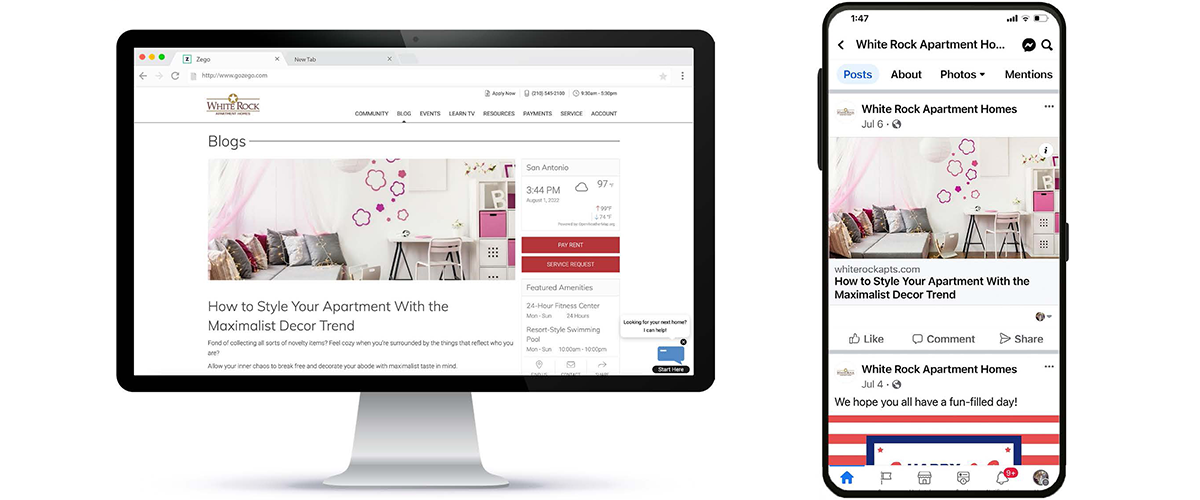
You don’t have to have a BA in English to craft a quick, relevant listicle or two. But if you just don’t have the time, host a blog writing contest between staff, hire a summer intern, or find a freelance writer on a site such as Upwork that connects talent with brands.
Develop articles for your target audience: people who are moving to the area. Offer valuable tips and suggestions to help newcomers navigate your city. Optimize your content with a key word or phrase, and you may attract visitors who are looking for a community like yours.
To get you started, here are a few blog post ideas from Parcel Pending:
- Everything You Need to Know About Living In [Property City]
- Top 10 Things to Do In [Property City]
- 20 Moving Tips To Save You Time and Money
- Top 15 Restaurants to Try in [Property City]
- Top 7 Gyms in [Property City]
- Top 20 Attractions in [Property City]
- 12 DIY Tips for Renters
The guide to creating a modern property management marketing plan for prospective residents
Once you’ve attracted prospective residents into the funnel, how do you effectively convert and retain them? Multifamily marketing experts revealed their strategies and best practices for prospect-to-resident conversion and retention in our free digital guide, Multifamily Property Marketing for the Resident Experience Revolution.
FREE GUIDE Explore property marketing trends impacting the industry, marketing ideas for property management, and learn how to create a multifamily marketing plan for the prospect-to-resident experience.

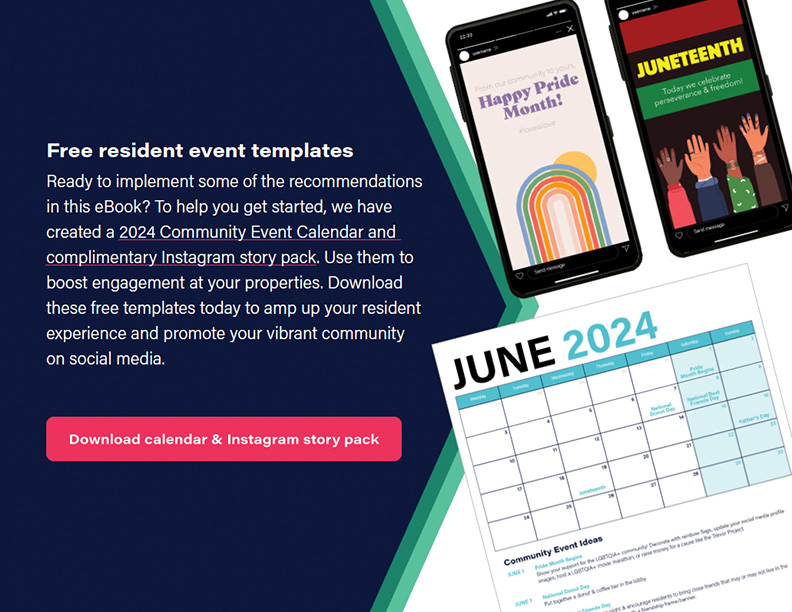
Multifamily Property Marketing for the Resident Experience Revolution